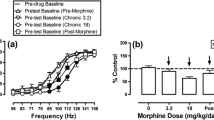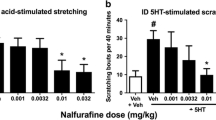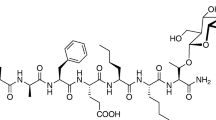Abstract
Rationale
Selective, centrally acting kappa opioid agonists produce antinociception in a wide range of preclinical assays, but these compounds perform poorly as analgesics in humans. This discrepancy may be related to the behavioral depressant effects of kappa agonists. Kappa antagonists do not typically produce antinociception, but they produce antidepressant-like effects in some preclinical assays.
Objective
The objective of this study was to test the hypothesis that the kappa agonist U69,593 and the kappa antagonist norbinaltorphimine would produce pronociceptive and antinociceptive effects, respectively, in an assay of pain-depressed behavior.
Methods
Effects of U69,593 (0.056–0.56 mg/kg), norbinaltorphimine (10–32 mg/kg), and morphine (3.2 mg/kg) were evaluated on the stimulation of a stretching response and the depression of intracranial self-stimulation (ICSS) of the medial forebrain bundle produced in rats by a common noxious stimulus (intraperitoneal administration of dilute lactic acid).
Results
U69,593 produced a dose-dependent blockade of acid-stimulated stretching but only exacerbated acid-induced depression of ICSS. Thus, U69,593 produced antinociception in the assay of pain-stimulated behavior but pronociceptive effects in the assay of pain-depressed behavior. Norbinaltorphimine did not alter acid-stimulated stretching or acid-induced depression of ICSS. The mu opioid agonist morphine blocked both acid-stimulated stretching and acid-induced depression of ICSS.
Conclusions
These results support the hypothesis that prodepressant effects of kappa agonists may limit their clinical utility as analgesics. These results do not support the use of kappa antagonists to treat depressant effects of pain. These findings illustrate the potential value of using complementary assays of pain-stimulated and pain-depressed behaviors for preclinical evaluation of candidate analgesics.






Similar content being viewed by others
Abbreviations
- norBNI:
-
Norbinaltorphimine
- ICSS:
-
Intracranial self-stimulation
References
Bair MJ, Robinson RL, Katon W, Kroenke K (2003) Depression and pain comorbidity: a literature review. Arch Intern Med 163:2433–2445
Bartok RE, Craft RM (1997) Sex differences in opioid antinociception. J Pharmacol Exp Ther 282:769–778
Beardsley PM, Howard JL, Shelton KL, Carroll FI (2005) Differential effects of the novel kappa opioid receptor antagonist, JDTic, on reinstatement of cocaine-seeking induced by footshock stressors vs cocaine primes and its antidepressant-like effects in rats. Psychopharmacology (Berl) 183:118–126
Blackburn-Munro G (2004) Pain-like behaviours in animals-how human are they? Trends Pharmacol Sci 25:299–305
Broadbear JH, Negus SS, Butelman ER, de Costa BR, Woods JH (1994) Differential effects of systemically administered nor-binaltorphimine (nor-BNI) on kappa-opioid agonists in the mouse writhing assay. Psychopharmacology (Berl) 115:311–319
Carlezon WA Jr, Chartoff EH (2007) Intracranial self-stimulation (ICSS) in rodents to study the neurobiology of motivation. Nat Protoc 2:2987–2995
Carlezon WA Jr, Beguin C, DiNieri JA, Baumann MH, Richards MR, Todtenkopf MS, Rothman RB, Ma Z, Lee DY, Cohen BM (2006) Depressive-like effects of the kappa-opioid receptor agonist salvinorin A on behavior and neurochemistry in rats. J Pharmacol Exp Ther 316:440–447
Catheline G, Kayser V, Idanpaan-Heikkila JJ, Guilbaud G (1996) The antinociceptive activity of kappa- but not delta-opioid receptor agonists is maintained in morphine-tolerant neuropathic rats. Eur J Pharmacol 318:273–281
Cleeland CS, Ryan KM (1994) Pain assessment: global use of the Brief Pain Inventory. Ann Acad Med Singapore 23:129–138
Cook CD, Barrett AC, Roach EL, Bowman JR, Picker MJ (2000) Sex-related differences in the antinociceptive effects of opioids: importance of rat genotype, nociceptive stimulus intensity, and efficacy at the mu opioid receptor. Psychopharmacology (Berl) 150:430–442
Di Chiara G, Imperato A (1988) Opposite effects of mu and kappa opiate agonists on dopamine release in the nucleus accumbens and in the dorsal caudate of freely moving rats. J Pharmacol Exp Ther 244:1067–1080
Dworkin RH, Turk DC, Wyrwich KW, Beaton D, Cleeland CS, Farrar JT, Haythornthwaite JA, Jensen MP, Kerns RD, Ader DN, Brandenburg N, Burke LB, Cella D, Chandler J, Cowan P, Dimitrova R, Dionne R, Hertz S, Jadad AR, Katz NP, Kehlet H, Kramer LD, Manning DC, McCormick C, McDermott MP, McQuay HJ, Patel S, Porter L, Quessy S, Rappaport BA, Rauschkolb C, Revicki DA, Rothman M, Schmader KE, Stacey BR, Stauffer JW, von Stein T, White RE, Witter J, Zavisic S (2008) Interpreting the clinical importance of treatment outcomes in chronic pain clinical trials: IMMPACT recommendations. J Pain 9:105–121
Dykstra LA, Massie CA (1988) Antagonism of the analgesic effects of mu and kappa opioid agonists in the squirrel monkey. J Pharmacol Exp Ther 246:813–821
Dykstra LA, Gmerek DE, Winger G, Woods JH (1987) Kappa opioids in rhesus monkeys. I. Diuresis, sedation, analgesia and discriminative stimulus effects. J Pharmacol Exp Ther 242:413–420
Endoh T, Matsuura H, Tanaka C, Nagase H (1992) Nor-binaltorphimine: a potent and selective kappa-opioid receptor antagonist with long-lasting activity in vivo. Arch Int Pharmacodyn Ther 316:30–42
Flecknell PA (1994) Refinement of animal use—assessment and alleviation of pain and distress. Lab Anim 28:222–231
Friese N, Diop L, Lambert C, Riviere PJ, Dahl SG (1997) Antinociceptive effects of morphine and U-50, 488H on vaginal distension in the anesthetized rat. Life Sci 61:1559–1570
Gallantine EL, Meert TF (2008) Antinociceptive and adverse effects of mu- and kappa-opioid receptor agonists: a comparison of morphine and U50488-H. Basic Clin Pharmacol Toxicol 103:419–427
Gureje O, Von Korff M, Kola L, Demyttenaere K, He Y, Posada-Villa J, Lepine JP, Angermeyer MC, Levinson D, de Girolamo G, Iwata N, Karam A, Guimaraes Borges GL, de Graaf R, Browne MO, Stein DJ, Haro JM, Bromet EJ, Kessler RC, Alonso J (2008) The relation between multiple pains and mental disorders: results from the World Mental Health Surveys. Pain 135:82–91
Jann MW, Slade JH (2007) Antidepressant agents for the treatment of chronic pain and depression. Pharmacotherapy 27:1571–1587
Ko MC, Butelman ER, Woods JH (1999) Activation of peripheral kappa opioid receptors inhibits capsaicin-induced thermal nociception in rhesus monkeys. J Pharmacol Exp Ther 289:378–385
Lepine JP, Briley M (2004) The epidemiology of pain in depression. Hum Psychopharmacol 19(Suppl 1):S3–S7
Machelska H, Pfluger M, Weber W, Piranvisseh-Volk M, Daubert JD, Dehaven R, Stein C (1999) Peripheral effects of the kappa-opioid agonist EMD 61753 on pain and inflammation in rats and humans. J Pharmacol Exp Ther 290:354–361
Mague SD, Pliakas AM, Todtenkopf MS, Tomasiewicz HC, Zhang Y, Stevens WC Jr, Jones RM, Portoghese PS, Carlezon WA Jr (2003) Antidepressant-like effects of kappa-opioid receptor antagonists in the forced swim test in rats. J Pharmacol Exp Ther 305:323–330
Mangel AW, Bornstein JD, Hamm LR, Buda J, Wang J, Irish W, Urso D (2008) Clinical trial: asimadoline in the treatment of patients with irritable bowel syndrome. Aliment Pharmacol Ther 28:239–249
Margolis EB, Hjelmstad GO, Bonci A, Fields HL (2003) Kappa-opioid agonists directly inhibit midbrain dopaminergic neurons. J Neurosci 23:9981–9986
Martin TJ, Buechler NL, Kahn W, Crews JC, Eisenach JC (2004) Effects of laparotomy on spontaneous exploratory activity and conditioned operant responding in the rat: a model for postoperative pain. Anesthesiology 101:191–203
Matson DJ, Broom DC, Carson SR, Baldassari J, Kehne J, Cortright DN (2007) Inflammation-induced reduction of spontaneous activity by adjuvant: a novel model to study the effect of analgesics in rats. J Pharmacol Exp Ther 320:194–201
McLaughlin JP, Marton-Popovici M, Chavkin C (2003) Kappa opioid receptor antagonism and prodynorphin gene disruption block stress-induced behavioral responses. J Neurosci 23:5674–5683
Mogil JS (2009) Animal models of pain: progress and challenges. Nat Rev Neurosci 10:283–294
Morton DB, Griffiths PHM (1985) Guidelines on the recognition of pain, distress and discomfort in experimental animals and an hypothesis for assessment. Vet Rec 116:431–436
National Research Council (1996) Guide for the care and use of laboratory animals. National Academy Press, Washington, DC
National Research Council (2003) Guidelines for the care and use of mammals in neuroscience and behavioral research. National Academy Press, Washington, DC
Negus SS, Mello NK (2002) Effects of gonadal steroid hormone treatments on opioid antinociception in ovariectomized rhesus monkeys. Psychopharmacology (Berl) 159:275–283
Negus SS, Vanderah TW, Brandt MR, Bilsky EJ, Becerra L, Borsook D (2006) Preclinical assessment of candidate analgesic drugs: recent advances and future challenges. J Pharmacol Exp Ther 319:507–514
Negus SS, Schrode K, Stevenson GW (2008) Mu/kappa opioid interactions in rhesus monkeys: implications for analgesia and abuse liability. Exp Clin Psychopharmacol 16:386–399
Negus SS, Bilsky EJ, Pereira Do Carmo G, Stevenson GW (2010) Rationale and methods for assessment of pain-depressed behavior in preclinical assays of pain and analgesia. In: Szallasi A (ed) Methods in molecular biology: analgesia. Humana Press, New York, Chapter 7
Pande AC, Pyke RE, Greiner M, Cooper SA, Benjamin R, Pierce MW (1996a) Analgesic efficacy of the kappa-receptor agonist, enadoline, in dental surgery pain. Clin Neuropharmacol 19:92–97
Pande AC, Pyke RE, Greiner M, Wideman GL, Benjamin R, Pierce MW (1996b) Analgesic efficacy of enadoline versus placebo or morphine in postsurgical pain. Clin Neuropharmacol 19:451–456
Pereira Do Carmo G, Folk JE, Rice KC, Chartoff E, Carlezon WA Jr, Negus SS (2009a) The selective non-peptidic delta opioid agonist SNC80 does not facilitate intracranial self-stimulation in rats. Eur J Pharmacol 604:58–65
Pereira Do Carmo G, Stevenson GW, Carlezon WA, Negus SS (2009b) Effects of pain- and analgesia-related manipulations on intracranial self-stimulation in rats: further studies on pain-depressed behavior. Pain 144:170–177
Portoghese PS, Lipkowski AW, Takemori AE (1987) Binaltorphimine and norbinaltorphimine, potent and selective kappa opioid receptor antagonists. Life Sci 40:1287–1292
Seguin L, Le Marouille-Girardon S, Millan MJ (1995) Antinociceptive profiles of non-peptidergic neurokinin1 and neurokinin2 receptor antagonists: a comparison to other classes of antinociceptive agent. Pain 61:325–343
Stellar JR, Stellar E (1985) The neurobiology of motivation and reward. Springer-Verlag, New York
Stevenson GW, Bilsky EJ, Negus SS (2006) Targeting pain-suppressed behaviors in preclinical assays of pain and analgesia: effects of morphine on acetic acid-suppressed feeding in C57BL/6J mice. J Pain 7:408–416
Stevenson GW, Cormier J, Mercer H, Adams C, Dunbar C, Negus SS, Bilsky EJ (2009) Targeting pain-depressed behaviors in preclinical assays of pain and analgesia: drug effects on acetic acid-depressed locomotor activity in ICR mice. Life Sci 85:309–315
Takemori AE, Schwartz MM, Portoghese PS (1988) Suppression by nor-binaltorphimine of kappa opioid-mediated diuresis in rats. J Pharmacol Exp Ther 247:971–974
Todtenkopf MS, Marcus JF, Portoghese PS, Carlezon WA Jr (2004) Effects of kappa-opioid receptor ligands on intracranial self-stimulation in rats. Psychopharmacology (Berl) 172:463–470
Ungless MA, Magill PJ, Bolam JP (2004) Uniform inhibition of dopamine neurons in the ventral tegmental area by aversive stimuli. Science 303:2040–2042
Vierck CJ, Hansson PT, Yezierski RP (2008) Clinical and pre-clinical pain assessment: are we measuring the same thing? Pain 135:7–10
Vonvoigtlander PF, Lahti RA, Ludens JH (1983) U-50, 488: a selective and structurally novel non-Mu (kappa) opioid agonist. J Pharmacol Exp Ther 224:7–12
Wadenberg ML (2003) A review of the properties of spiradoline: a potent and selective kappa-opioid receptor agonist. CNS Drug Rev 9:187–198
Whiteside GT, Adedoyin A, Leventhal L (2008) Predictive validity of animal pain models? A comparison of the pharmacokinetic-pharmacodynamic relationship for pain drugs in rats and humans. Neuropharmacology 54:767–775
Acknowledgments
This work was supported in part by grants R01-DA11460 from the National Institute on Drug Abuse and R01-NS070715 from the National Institute on Neurological Disorders and Stroke. A portion of this work was also supported by the Intramural Research Programs of the National Institute on Drug Abuse and the National Institute on Alcohol Abuse and Alcoholism.
Author information
Authors and Affiliations
Corresponding author
Rights and permissions
About this article
Cite this article
Negus, S.S., Morrissey, E.M., Rosenberg, M. et al. Effects of kappa opioids in an assay of pain-depressed intracranial self-stimulation in rats. Psychopharmacology 210, 149–159 (2010). https://doi.org/10.1007/s00213-009-1770-6
Received:
Accepted:
Published:
Issue Date:
DOI: https://doi.org/10.1007/s00213-009-1770-6




